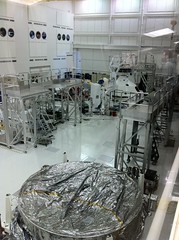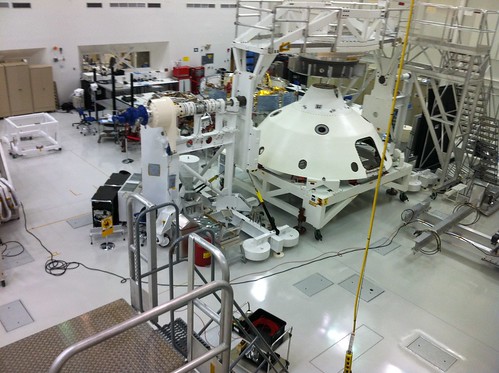Saturday afternoon I received a call from a news producer at the BBC — could I come talk about the Mars Science Laboratory, launched earlier that day?
This was a tough question, publicity-monger though I am: I don’t actually know anything about Mars. I suppose to people outside of the very broad field of “astronomy”, studying the planets in the solar system is not very different from studying the Cosmic Microwave Background. After all, in both cases we use telescopes and satellites. But actually, the study of planets is much closer to geology (and, with increasing interest in the possibilities of life on those planets, to biology) than astronomy per se.
Nonetheless, I did actually know a little about the Mars Science Laboratory and its Curiosity rover: when I was visiting the Jet Propulsion Laboratory earlier this year (to work on the CMB), our group took a quick field trip across the lab to the shop where the satellite was being assembled. Everything else I admit that I learned from wikipedia and NASA PR materials in the two hours before the interview.
One of the difficulties in getting to the surface of Mars arises from its tenuous atmosphere: parachutes aren’t a very efficient braking system. Instead, the igloo-shaped structure above and below is part of the “Sky Crane“, an amazing contraption that will hover and lower the rover gently down to the Martian surface. The Curiosity rover itself is possibly the most sophisticated robot we’ve ever put on another planet: about the size of a Mini, it will scoot around the neighbourhood of the landing site, performing experiments and sending the results back to the human race. My favourite instrument is the ChemCam, which will use “laser induced breakdown spectroscopy” to analyse rocks on the Martian surface. This is the very science-fictiony idea of shooting a high-energy laser beam at a rock, high enough to vaporise it, and then take a careful spectroscopic picture of that vapour, which scientists will decode and use to figure out the rock’s constituent elements. (Of course if there were any real Martians, they might not take kindly to our shooting laser beams at their rocks, in which case we may need to figure out a defense against the Illudium Q-36 Explosive Space Modulator.)
Martians are, of course, one of the most important parts of MSL’s mission and the broader international program of exploring Mars. NASA is very careful to point out, however, that the point of the current mission is not to find life per se, but to help determine Mars’ habitability: could Mars now support life, or could it have in the past? The actual hunt for life will have to wait for a future mission.

